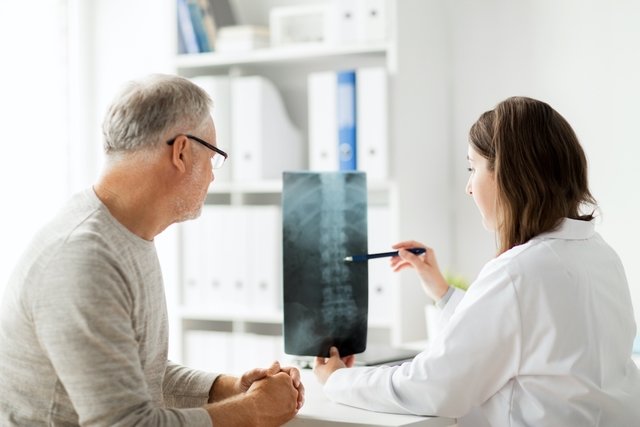Degenerative disc disease is the progressive wear and tear of the intervertebral discs in the spine, caused by the natural aging of the body, and is common in people over 40 years of age. Generally, this wear does not cause pain, however, in some cases, pain in the lower back, back or neck, tingling sensation or weakness in the arms or legs, for example, may appear.
Intervertebral discs are cartilages located between the vertebrae of the spine with the function of cushioning impacts and providing flexibility to the spine. Thus, disc degeneration impairs the function of the vertebral disc itself and can also put pressure on other important structures of the spine, such as the nerve root or spinal cord.
The diagnosis of degenerative disc disease, which is also called disc degeneration, is made by an orthopedist, who can indicate the most appropriate treatment, which can be done with the use of medicines, such as anti-inflammatories or analgesics, to relieve pain, physiotherapy and , in some cases, surgery.

Symptoms of degenerative disc disease
The main symptoms of degenerative disc disease are:
- Lumbar or lower back pain, which can radiate to the buttocks, thighs or legs;
- Pain in the back of the neck that can radiate to the arms, shoulder or ribs;
- Difficulty moving the neck;
- Feeling of numbness or tingling in the arms or legs;
- Muscle weakness or loss of sensation in the arms or legs;
- Stiffness in the spine;
- Back pain that worsens when sitting, lifting or flexing the spine;
- Pain that improves when lying down, walking or changing positions.
Degenerative disc disease does not always present symptoms and is usually discovered on imaging tests, such as magnetic resonance imaging or computed tomography.
However, these symptoms can appear when the intervertebral disc moves out of its correct position, or ruptures, causing a herniated disc. Know how to identify all the symptoms of a herniated disc.
Furthermore, wear and tear on the intervertebral discs can cause the vertebrae of the spine to become closer together and move forward, leading to a condition called spondylolisthesis, or it can cause a narrowing of the spaces around the spine, known as spinal stenosis.
How to confirm the diagnosis
The diagnosis of degenerative disc disease is made by the orthopedist through symptoms, health history, lifestyle habits and imaging tests, such as spinal X-rays, computed tomography or magnetic resonance imaging.
Taking care of your health has never been easier!
These imaging tests allow the doctor to evaluate the characteristics of the intervertebral discs, such as thinning or hardening of the disc, the presence of a herniated disc, or osteophytes, which are the growth of small bone structures in the vertebrae of the spine.
These changes in the intervertebral discs are more frequent in the lumbar region, between the L4-L5 vertebrae, or in the cervical region, between the C5-C6 vertebrae.
Possible causes
The most common cause of degenerative disc disease is the body’s natural aging process, which causes the intervertebral discs to lose water, becoming more dehydrated and thin.
Some factors may contribute to the development of degenerative disc disease, such as:
- Bad posture;
- Obesity;
- Sedentary lifestyle;
- Smoking habit;
- Injuries or trauma to the spine.
Furthermore, practicing vigorous exercise or working with repetitive physical effort, as in the case of drivers, secretaries or dentists, for example, can increase the risk of presenting some changes to the intervertebral disc.
Although degenerative disc disease is more common after age 40, it can also affect younger people.
How the treatment is carried out
The treatment of degenerative disc disease must be carried out under the guidance of an orthopedist, with the aim of relieving symptoms and preventing the worsening of intervertebral disc degeneration.
Therefore, some treatments that may be recommended by the orthopedist are:
1. Changes in lifestyle habits
Some changes in lifestyle habits may be recommended by the orthopedist in cases of degenerative disc disease, without symptoms and without a herniated disc, as a way to preserve the spine, prevent the progression of disc degeneration and the emergence of symptoms.
Therefore, the main recommendations are:
- Maintain good posture when walking, sitting, lying, sleeping or standing;
- Avoid making excessive physical effortsand whenever it is necessary to lift heavy objects, you must do it correctly, without straining your spine;
- Practice physical exerciseto strengthen the back muscles, under the guidance of the physical educator, 2 to 3 times a week;
- Do stretching exercises dailyas they help prepare the spinal muscles for everyday activities and help prevent injuries;
- Quit smoking.
Furthermore, it is important to maintain a healthy weight, eating a balanced diet, as excess weight can overload the spine and increase the risk of developing the symptoms of degenerative disc disease. Learn how to eat a balanced diet.
2. Use of medicines
The remedies recommended by the orthopedist for degenerative disc disease aim to reduce pain and discomfort in the spine.
The main remedies that may be indicated are:
- Anti-inflammatories;
- Analgesics;
- Muscle relaxants.
In addition, there are other medications that may be indicated for degenerative disc disease, such as corticosteroid injections, applied by the doctor to the spine via epidural, to quickly relieve pain and inflammation.
3. Physiotherapy
Physiotherapy may be recommended by the orthopedist if the person has difficulty limiting movement or to relieve pain more quickly.
Physiotherapy sessions must be carried out with the guidance of a physiotherapist, respecting each person’s limitations, and stretching exercises may be recommended to increase flexibility and improve spinal stability.
In addition, exercises can be performed to strengthen the back muscles and abdominal muscles, which support the spine, which helps to reduce the movement of the vertebrae, reduce inflammation and, consequently, relieve pain. Find out how physiotherapy for the spine is performed.
4. Surgery
Surgery is recommended by the doctor in cases where no other treatment option has been effective in controlling the pain of degenerative disc disease, and is generally performed by removing the damaged parts of the affected intervertebral disc, which relieves compression of the nerves around the vertebra.
Normally, after surgery, the orthopedist may recommend physiotherapy, which serves as an aid to post-surgical recovery, muscle strengthening, analgesia and improvement in posture.

Sign up for our newsletter and stay up to date with exclusive news
that can transform your routine!
Warning: Undefined array key "title" in /home/storelat/public_html/wp-content/plugins/link-whisper-premium/templates/frontend/related-posts.php on line 12
Warning: Undefined array key "title_tag" in /home/storelat/public_html/wp-content/plugins/link-whisper-premium/templates/frontend/related-posts.php on line 13



